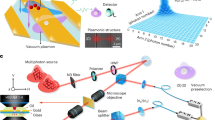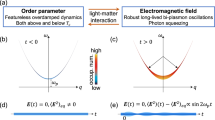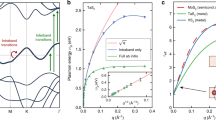Abstract
At the interface of classical and quantum physics, the Maxwell and Schrödinger equations describe how optical fields drive and control electronic phenomena to enable lightwave electronics at terahertz or petahertz frequencies and on ultrasmall scales1,2,3,4,5. The electric field of light striking a metal interacts with electrons and generates light–matter quasiparticles, such as excitons6 or plasmons7, on an attosecond timescale. Here we create and image a quasiparticle of topological plasmonic spin texture in a structured silver film. The spin angular momentum components of linearly polarized light interacting with an Archimedean coupling structure with a designed geometric phase generate plasmonic waves with different orbital angular momenta. These plasmonic fields undergo spin–orbit interaction and their superposition generates an array of plasmonic vortices. Three of these vortices can form spin textures that carry non-trivial topological charge8 resembling magnetic meron quasiparticles9. These spin textures are localized within a half-wavelength of light, and exist on the timescale of the plasmonic field. We use ultrafast nonlinear coherent photoelectron microscopy to generate attosecond videos of the spatial evolution of the vortex fields; electromagnetic simulations and analytic theory confirm the presence of plasmonic meron quasiparticles. The quasiparticles form a chiral field, which breaks the time-reversal symmetry on a nanometre spatial scale and a 20-femtosecond timescale (the ‘nano-femto scale’). This transient creation of non-trivial spin angular momentum topology pertains to cosmological structure creation and topological phase transitions in quantum matter10,11,12, and may transduce quantum information on the nano-femto scale13,14.
This is a preview of subscription content, access via your institution
Access options
Access Nature and 54 other Nature Portfolio journals
Get Nature+, our best-value online-access subscription
$29.99 / 30 days
cancel any time
Subscribe to this journal
Receive 51 print issues and online access
$199.00 per year
only $3.90 per issue
Buy this article
- Purchase on Springer Link
- Instant access to full article PDF
Prices may be subject to local taxes which are calculated during checkout




Similar content being viewed by others
Data availability
The data that support the reported findings of this study are available from the corresponding authors on reasonable request.
References
Corkum, P. B. & Krausz, F. Attosecond science. Nat. Phys. 3, 381–387 (2007).
Langer, F. et al. Lightwave-driven quasiparticle collisions on a subcycle timescale. Nature 533, 225–229 (2016).
Higuchi, T., Heide, C., Ullmann, K., Weber, H. B. & Hommelhoff, P. Light-field-driven currents in graphene. Nature 550, 224–228 (2017).
Ciappina, M. F. et al. Attosecond physics at the nanoscale. Rep. Prog. Phys. 80, 054401 (2017).
Reimann, J. et al. Subcycle observation of lightwave-driven Dirac currents in a topological surface band. Nature 562, 396–400 (2018).
Silkin, V. M., Lazić, P., Došlić, N., Petek, H. & Gumhalter, B. Ultrafast electronic response of Ag(111) and Cu(111) surfaces: from early excitonic transients to saturated image potential. Phys. Rev. B 92, 155405 (2015).
Pitarke, J. M., Silkin, V. M., Chulkov, E. V. & Echenique, P. M. Theory of surface plasmons and surface-plasmon polaritons. Rep. Prog. Phys. 70, 1–87 (2007).
Anderson, P. W. When the electron falls apart. Phys. Today 50, 42–47 (1997).
Nagaosa, N. & Tokura, Y. Topological properties and dynamics of magnetic skyrmions. Nat. Nanotechnol. 8, 899–911 (2013).
Haldane, F. & Duncan, M. Nobel lecture: topological quantum matter. Rev. Mod. Phys. 89, 040502 (2017).
Zurek, W. H. Cosmological experiments in condensed matter systems. Phys. Rep. 276, 177–221 (1996).
Kibble, T. W. Some implications of a cosmological phase transition. Phys. Rep. 67, 183–199 (1980).
Rubinsztein-Dunlop, H. et al. Roadmap on structured light. J. Opt. 19, 013001 (2017).
Bliokh, K. Y., Rodríguez-Fortuño, F. J., Nori, F. & Zayats, A. V. Spin–orbit interactions of light. Nat. Photon. 9, 796–808 (2015); erratum 11, 137 (2017).
Hopfield, J. J. Theory of the contribution of excitons to the complex dielectric constant of crystals. Phys. Rev. 112, 1555–1567 (1958).
Echenique, P. M., Pitarke, J. M., Chulkov, E. V. & Rubio, A. Theory of inelastic lifetimes of low-energy electrons in metals. Chem. Phys. 251, 1–35 (2000).
Skyrme, T. H. R. A unified field theory of mesons and baryons. Nucl. Phys. 31, 556–569 (1962).
Yu, X. Z. et al. Real-space observation of a two-dimensional skyrmion crystal. Nature 465, 901–904 (2010).
Lin, S.-Z. et al. Topological defects as relics of emergent continuous symmetry and Higgs condensation of disorder in ferroelectrics. Nat. Phys. 10, 970–977 (2014).
Davis, T. J. et al. Ultrafast vector imaging of plasmonic skyrmion dynamics with deep subwavelength resolution. Science 368, eaba6415 (2020).
Du, L., Yang, A., Zayats, A. V. & Yuan, X. Deep-subwavelength features of photonic skyrmions in a confined electromagnetic field with orbital angular momentum. Nat. Phys. 15, 650–654 (2019).
Tsesses, S. et al. Optical skyrmion lattice in evanescent electromagnetic fields. Science 361, 993–996 (2018).
Bliokh, K. Y. & Nori, F. Transverse and longitudinal angular momenta of light. Phys. Rep. 592, 1–38 (2015).
Bliokh, K. Y., Smirnova, D. & Nori, F. Quantum spin Hall effect of light. Science 348, 1448–1451 (2015).
Van Mechelen, T. & Jacob, Z. Universal spin-momentum locking of evanescent waves. Optica 3, 118–126 (2016).
Kim, H. et al. Synthesis and dynamic switching of surface plasmon vortices with plasmonic vortex lens. Nano Lett. 10, 529–536 (2010).
Ohno, T. & Miyanishi, S. Study of surface plasmon chirality induced by Archimedes’ spiral grooves. Opt. Express 14, 6285–6290 (2006).
Spektor, G. et al. Revealing the subfemtosecond dynamics of orbital angular momentum in nanoplasmonic vortices. Science 355, 1187–1191 (2017).
Barnett, S. M. et al. On the natures of the spin and orbital parts of optical angular momentum. J. Opt. 18, 064004 (2016).
Kubo, A., Pontius, N. & Petek, H. Femtosecond microscopy of surface plasmon polariton wave packet evolution at the silver/vacuum interface. Nano Lett. 7, 470–475 (2007).
Fösel, T., Peano, V. & Marquardt, F. L lines, C points and Chern numbers: understanding band structure topology using polarization fields. New J. Phys. 19, 115013 (2017).
Horn, B. K. P. & Schunck, B. G. Determining optical flow. Artif. Intell. 17, 185–203 (1981).
Dai, Y. et al. Ultrafast microscopy of a plasmonic spin skyrmion. Preprint at http://arXiv.org/abs/1912.03826 (2019).
Van Mechelen, T. & Jacob, Z. Photonic Dirac monopoles and skyrmions: spin-1 quantization. Opt. Mater. Express 9, 95–111 (2019).
Kimel, A. V. et al. Ultrafast non-thermal control of magnetization by instantaneous photomagnetic pulses. Nature 435, 655–657 (2005).
Xiao, D., Liu, G.-B., Feng, W., Xu, X. & Yao, W. Coupled spin and valley physics in monolayers of MoS2 and other group-VI dichalcogenides. Phys. Rev. Lett. 108, 196802 (2012).
Bauer, E. Surface Microscopy with Low Energy Electrons (Springer, 2014).
Dąbrowski, M., Dai, Y. & Petek, H. Ultrafast microscopy: imaging light with photoelectrons on the nano–femto scale. J. Phys. Chem. Lett. 8, 4446–4455 (2017).
Dąbrowski, M., Dai, Y. & Petek, H. Ultrafast photoemission electron microscopy: imaging plasmons in space and time. Chem. Rev. 120, 6247–6287 (2020).
Podbiel, D. et al. Imaging the nonlinear plasmoemission dynamics of electrons from strong plasmonic fields. Nano Lett. 17, 6569–6574 (2017).
Kahl, P. et al. Normal-incidence photoemission electron microscopy (NI-PEEM) for imaging surface plasmon polaritons. Plasmonics 9, 1401–1407 (2014).
Cardano, F., Karimi, E., Marrucci, L., de Lisio, C. & Santamato, E. Generation and dynamics of optical beams with polarization singularities. Opt. Express 21, 8815–8820 (2013).
Petek, H. & Ogawa, S. Femtosecond time-resolved two-photon photoemission studies of electron dynamics in metals. Prog. Surf. Sci. 56, 239–310 (1997).
Reutzel, M., Li, A., Wang, Z. & Petek, H. Coherent multidimensional photoelectron spectroscopy of ultrafast quasiparticle dressing by light. Nat. Commun. 11, 2230 (2020).
Li, C. M., Urbach, L. E. & Dai, H. L. Second-harmonic generation from a Ag(111) surface at the interband transition region: role of the dielectric function. Phys. Rev. B 49, 2104–2112 (1994).
Spektor, G. et al. Mixing the light spin with plasmon orbit by nonlinear light-matter interaction in gold. Phys. Rev. X 9, 021031 (2019).
Rosch, A. Magnetic skyrmions: particles or waves. Nat. Mater. 15, 1231–1232 (2016).
Vuong, L. T. et al. Experiments showing orbital angular momentum exchange with optical vortices. In International Quantum Electronics Conference 2007 IG2_3 (OSA, 2007).
Computer Vision Toolbox, MATLAB (MathWorks, 2018).
Acknowledgements
This research was supported by the NSF Center for Chemical Innovation on Chemistry at the Space-Time Limit, grant CHE-1414466. The authors thank L. Vuong for advice on the plasmonic flow analysis, A. Kosowsky for illuminating discussion of the role of phase transitions in cosmological structure formation and J. Chen at the Peterson Institute of NanoScience and Engineering for help in sample preparation.
Author information
Authors and Affiliations
Contributions
Y.D. performed the experiments and simulations, processed and analysed the data, and generated the figures; Z.Z. helped with the sample preparation and performing the experiments; Y.D., Z.Z. and A.G. developed the analytical model for topological quasiparticles; R.S.K.M. advised on the topological properties of quasiparticles; A.K. explained the PEEM imaging of plasmonic phenomena; C.-B.H. supervised the research on plasmonic vortices, performed simulations of experiments and participated in the data interpretation, H.P. guided interpretation of the data as a realization of topological quasiparticles, wrote the manuscript and supervised the research; all authors contributed to the discussion.
Corresponding authors
Ethics declarations
Competing interests
The authors declare no competing interests.
Additional information
Publisher’s note Springer Nature remains neutral with regard to jurisdictional claims in published maps and institutional affiliations.
Extended data figures and tables
Extended Data Fig. 1 Diagram of the nonlinear two-photon photoelectron emission process that forms the PEEM images.
The recorded photoelectron count images are created by electrons absorbing two energy quanta (2ħωL) from the total electric fields at the surface, EL + Elong + Ez, exciting them above Evac (left). The light quanta can be supplied either from a single pulse, or from a coherent superposition of fields from a pump–probe pulse pair with a variable time delay; the PEEM records the spatial distribution of photoelectrons excited by the total field. Right, the superposition of EL (shown as solid (dotted) grey lines) with wavelength λL and the parallel (anti-parallel) Elong (the tangential component of the SPP field at the vacuum/Ag interface, which oscillates between the Ez and Elong character; the solid and dotted curved lines signify a change in the SPP field sign in the same sense as for EL) fields with wavelength λSPP creates the total in-plane field with a modulation period of λSPP, as shown by the green curve. The PEEM signal is integrated over many excitation cycles, so the experimental time resolution is encoded by how interferences evolve with the pump–probe delay.
Extended Data Fig. 2 Raw static PEEM image of the plasmonic vortex.
Top, image presented on a logarithmic colour scale. The vertical dashed lines approximately delineate the regions dominated by self-interference and SPP interference, as described in the text. Bottom, the horizontal line intensity profile shows the vertically integrated signal within the white rectangle centred on the vortex. The interferences occur with λSPP and λSPP/2 periods.
Extended Data Fig. 3 Interferograms of photoemission (PE) yields.
a, 2PP yields recorded at single pixels from selected regions within the vortex (inset). The reference 2PP signal is recorded from a flat Ag surface region. The scans are translated vertically for easier viewing. b, Phase distribution (the red and blue colours signify opposite phases) of the y component of Elong relative to the excitation field. c, Fourier transform of the 2PP yield, as a function of polarization energy, which is defined by ħωL. The square filtering function of 1 eV width centred at 1ħωL indicates the selected energy range for the inverse Fourier transformation to obtain Supplementary Video 2. A second-order correlation process also includes the 2ħωL signal, which is not evaluated. The vertical scale is normalized at the 0ħωL peak maximum. Scale bars in a and b, λSPP.
Extended Data Fig. 4 ITR-PEEM images of the SPP vortex corresponding to the same time delays as in Fig. 2d.
The time delay increases from τ (leftmost image) to τ + 0.9 fs (rightmost image). a, The raw PEEM data; b, absolute values of the phase-independent 0ħωL Fourier component. c, The real part (amplitude) of the Ey component of the SPP field from the inverse Fourier transform of the 1ħωL signal. The asterisk and white lines mark the evolution of two components with the opposite phase as Δτ is advanced. Scale bars, λSPP.
Extended Data Fig. 5 The FDTD simulated field evolution in 1/2 an optical cycle at the SPP vortex excited by 550-nm y-polarized light.
The fields from top to bottom represent Ez and y and x components of Elong. For an m = 2 Archimedean spiral structure, the optical phase evolves by π from left to right. Note that the stronger Ez component is plotted with a different colour scale than the x and y components. Scale bars, λSPP/2.
Extended Data Fig. 6 Topological properties of plasmonic vortex system.
a, L-line map of a 2 μm × 2 μm region about the central vortex. The central domains are surrounded by apple-shaped toroids that are delimited by dashed lines and repeat with an approximate periodicity of λSPP (along the y direction) to infinity. Different domains of interest are coloured and labelled with the corresponding topological charge. Black dots mark the phase singularities, within these regions. b, Normalized spin texture overlapped by the L-line map in a. The colour map and arrows indicate the spin components, as in Supplementary Fig. 3b. c, d, Enlarged spin textures at side phase singularities indicated by the square shading in c. e, f, Spin texture in the same region as in c, d, but with the sign of positive Sz reversed, while conserving the topological charge. Black dots in c, d indicate positions of the phase singularities.
Extended Data Fig. 7 Phase change of the Ez associated with the phase singularities.
a, Phase change of Ez around the central and the two side phase singularities at y = 0 and ±λSPP/2 in the dumb-bell region. b, Phase change of Ez around of the phase singularities along the x and y axes shown in Extended Data Fig. 6c, d. The opposite phase change along the x and y axes results from the opposite vorticity causing the topological charges of apple toroid domains to be zero.
Extended Data Fig. 8 Selected slices of the experimental plasmonic flow illustrating L-line formation, persistence and decay.
The delay times given at the top of each panel are normalized by the optical cycle. They are obtained from ITR-PEEM images with the probe pulse interacting with the sample before, during and after the generation of the plasmonic vortex (labelled ‘Pre-vortex’, ‘Established vortex’ and ‘After vortex’, respectively).
Supplementary information
Supplementary Information
This file contains (A) Analytical formalism of the Plasmonic Vortex Fields; (B) Formalism of the Topological SAM Textures; Supplementary References; and Supplementary Figure 1-3.
Supplementary Video 1
. Raw ITR-PEEM movie of plasmonic vortex The experimental ITR-PEEM data showing the spatial distribution of the 2PP signal from the SPP plasmonic vortex; PEEM images are taken in pump-probe delay increments between identical pulses of ~100 as.
Supplementary Video 2
. Fourier filtered plasmon vortex at 1ω The component of the Fourier transformed signal (absolute value) from Video 1 at the laser driving frequency, 1ωL, is inverse Fourier transformed. This extracts the interference signal between the SPP and the probe optical pulse fields at the sample, enabling imaging of the vortex gyration about the vortex core. This SPP field gyration generates the spin angular momentum meron texture.
Supplementary Video 3
. The L-line singularity distribution The L-line distribution for a single pulse generated at the optical vortex. The bright contrast corresponds to high ellipticity of the x,y polarized SPP field, where the polarization is nearly linear and SAM points in the x,y plane orthogonal to the propagation k-vector. The central hourglass domain and the dumbbell region that are constant on ±20 fs time scale contain the meron-like SAM texture, and define the integration boundaries that obtain the topological charge of +1/2/per domain or +3/2 total. Time zero corresponds to maximum in the SPP vortex field.
Supplementary Video 4
. SAM quasiparticle density distribution. The video shows the evolution of SAM quasiparticle density. Integrating the density within the specified L-line domains in Video 3, gives topological charges of +1/2 and +3/2, respectively.
Rights and permissions
About this article
Cite this article
Dai, Y., Zhou, Z., Ghosh, A. et al. Plasmonic topological quasiparticle on the nanometre and femtosecond scales. Nature 588, 616–619 (2020). https://doi.org/10.1038/s41586-020-3030-1
Received:
Accepted:
Published:
Issue Date:
DOI: https://doi.org/10.1038/s41586-020-3030-1
This article is cited by
-
Attosecond electron microscopy by free-electron homodyne detection
Nature Photonics (2024)
-
Real-time tracking of coherent oscillations of electrons in a nanodevice by photo-assisted tunnelling
Nature Communications (2024)
-
Optical skyrmions and other topological quasiparticles of light
Nature Photonics (2024)
-
Focused surface plasmon polaritons coherently couple to electronic states in above-threshold electron emission
Communications Physics (2023)
-
Revealing low-loss dielectric near-field modes of hexagonal boron nitride by photoemission electron microscopy
Nature Communications (2023)
Comments
By submitting a comment you agree to abide by our Terms and Community Guidelines. If you find something abusive or that does not comply with our terms or guidelines please flag it as inappropriate.



